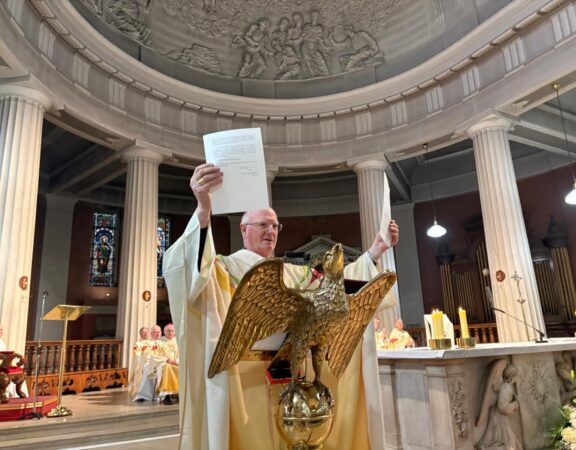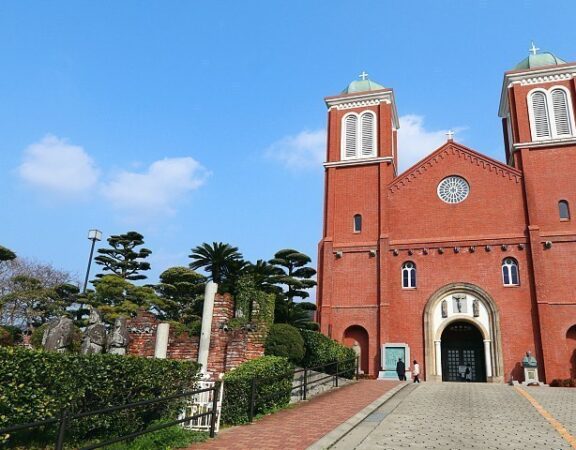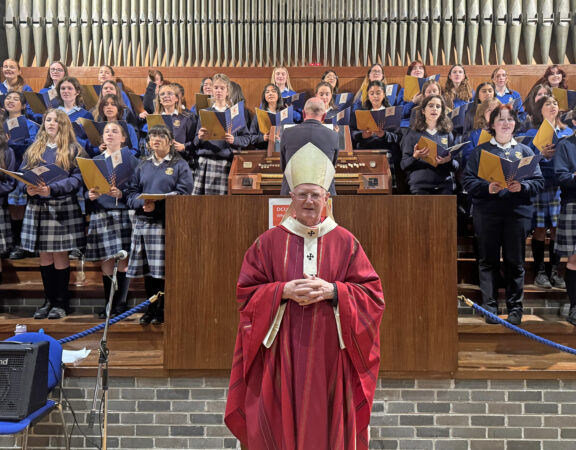Third Sunday of Advent 2014
MASS AT THE CHURCH OF OUR LADY OF THE WAYSIDE, KILTERNAN
Homily notes of Most Rev. Diarmuid Martin Archbishop of Dublin
Church of Our Lady of the Wayside, Kilternan, 14th December 2014
“Once again in today’s Gospel we encounter the extraordinary figure of John the Baptist. As we prepare for the celebration of the birth of the Lord at Christmas, we meet John as the one who comes ahead of Jesus, re-awakening expectation and hope, calling people to penance and conversion.
Who is John the Baptist? John is a prophet and a witness. As a witness John‘s life is entirely dedicated to understanding and living out the message of salvation. John’s life-style is determined by that message and nothing else. He lives in the wilderness isolated from any centre of political power or of the temple. His food and clothing are signs of absolute austerity and simplicity. John stands starkly alone with his prophetic call. He is not surrounded by a court of spin doctors, or managers or sponsors or others who try to make his message more palatable. He never compromises. He speaks with clarity, with a clarity which will finally lead him to imprisonment and death. He never compromises his uncomfortable message, yet the people keep coming in huge numbers to John. Why: Integrity attracts.
Who is John the Baptist? This is obviously a question which was being asked widely at that time. In today’s Gospel, John is confronted by those involved in the administration of worship in the temple and also by the more learned men whose task was the interpretation of the law. They want answers.
Do John’s answers satisfy? A prophet’s identity and personal integrity is not easy to classify within categories set by others. Integrity attracts, but integrity does not give easy, simplistic, ready-made answers. Integrity changes the goalposts of the questions we ask. Integrity upsets our sense of security; it challenges each of us to search into our own hearts as to what integrity really means for us.
John’s identity belongs clearly to the tradition of Old Testament prophets. He is an ascetic preacher who goes into the wilderness. He stands for an uncompromising distancing from the general life style of the day. He stands for a break with empty tradition and superficiality. Yet John is also without any trace of arrogance or self-importance. His relationship with the one he is called to announce is such that he simply proclaims that he is not worthy even to perform the most humble service.
John made a real impact on the society of his time. The numbers who flocked to him were enormous. He was one who did not just prophecy in general terms. John addressed the concrete questions of those who were searching for meaning for their lives. Those who encountered him knew that they must change their lives. Those who came to him asked: “what are we to do?”
Even though he was and remained a Jewish Saint, John the Baptist is a symbol of the Church. The figure of John serves as a warning to us today, to all believers, to the Church and to Church organizations of every age of our need to draw our strength from Christ alone, rather than from identifying with the cultural patterns and fashions of the day, which in any case come and go.
There will always be a tension in the relationship between Church and society. The Message of Jesus Christ has to be understood and lived out within the cultural realities of the world which is ours. Faith is never a flight from reality. It is not a comfort zone into which we can retreat and ignore the tough and demanding questions of today. Our faith must be twenty-first century faith.
Yet faith is also a call to witness. This means that although faith has to be lived in whatever world we live in, it never simply belongs to that world and must be such that it enables us to discern and break out of what is conventional at any individual moment.
This is not easy. We can easily become victims of the inadequacies and deceptions of the culture in which we live. We can be trapped and fail to see the shallowness of many aspects of life. Many who today decry the errors of the recent past in our Irish society and economy quickly forget how much all of us in our own way were part of a culture of empty celebrity in the days of prosperity in Ireland.
The message of Jesus is not a message which can leave us comfortable or passive. The opposite of prophecy and witness is empty conformity. The opposite of integrity is not just dishonesty but also apathy and resignation and not doing anything.
The Church’s message must however be a message of hope and of rejoicing. There are many reasons to be anxious about the Church today. Numbers attending Mass have gone down, due to a changed vision of life and the decision of many to live their life without any reference to God, as well as through scandals and how they were managed. Yet you also know that the community which has grown around this Church over decades has been a focal point of Christian care in the community and of education in a faith that produces good works. This Church has impacted on so many lives, in public events and in the quiet of hidden prayer.
I am pleased to see this Church so beautifully restored. It is an unusual Church, probably among the best known Churches in our diocese. So many people will simply have passed by this Church on their journeying. Many will however never have been inside the Church. For them it is just a Church on the wayside.
On various occasions recently I have had the joy to be present for the dedication of refurbished Churches in different parts of the diocese. It is wonderful to have a moment beforehand to walk about and see the particulars of what has been achieved and the details of restored beauty. However, for me the great moment is that moment when Mass begins and the newly refurbished building becomes renewed congregation, breaking into prayer and praise. Refurbishing a Church is never just a matter of re-establishing past beauty. It is about renewal, it is about the future.
John the Baptist was the first prophet in Old Testament tradition for centuries. He brought rebirth to the tradition of witness and prophecy. He re-awakened expectation and signalled a new future in Jesus Christ. Like those who encountered John the Baptist in the wilderness once we encounter Jesus, we can never again be happy to return ensconced in the comfort and superficiality or even the external beauty of the world out of which we came. When one stage of parish renewal is concluded, another always begins.
The Christian message has the ability to fascinate and challenge in every age. Our young people need to hear Christ’s message in its clarity and in all its demands. I hope that the younger people of this parish and this area will hear the message and the call of Jesus and will respond with integrity, creativity and generosity. As a believing community, we need to become a landmark not just along the roadside, but a landmark along the wayside of young people’s search for what is true and worthy and loving. We need to help young people to see that the true foundation of meaning and hope and of true joy in life comes in the message of that person whom John the Baptist identified: “He is the one”. ENDS







